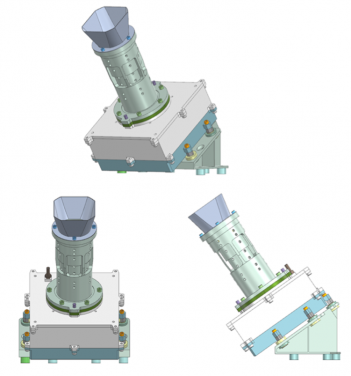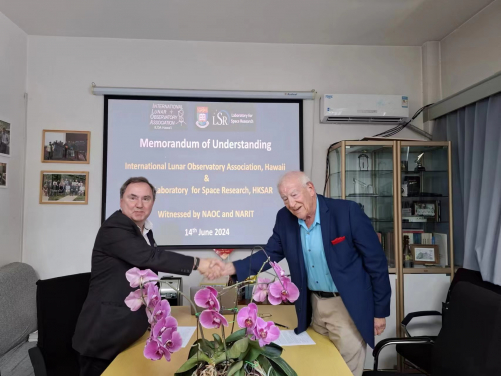Media
HKU and ILOA Signed MoU to Partner on the ILO-C Chang’E-7
Moon Lander Mission Launching 2026
20 Jun 2024
- 1 / 2
- 2 / 2
The Laboratory for Space Research at The University of Hong Kong (HKU-LSR) signed a Letter of Intent (LoI) with the International Lunar Observatory Association Hawai’i (ILOA) on May 16 2024, establishing an equal partnership to participate in one of the ILOA-led Chang’e 7 lunar missions - a small, wide-field optical telescope named ILO-C. The HKU-LSR telescope design has been formally chosen, and work has begun in earnest. ILO-C will be installed on the approved Chang’E-7 lunar lander in 2026.
A formal MoU signing for broader future cooperation for lunar exploration and education took place in Beijing on June 14. The Founding Director of the mission lead organisation, Steve Durst of ILOA Hawai’i, signed with the Director of the HKU-LSR, Professor Quentin PARKER. Group leader of Sky Survey from the National Astronomical Observatories of Chinese Academy of Sciences (NAOC) Suijian XUE and the National Astronomical Research Institute of Thailand (NARIT) have also joined this MoU under observer status with the intention for its collaboration on the project to expand in the future. The ILOA-HKU partners intend to produce the best possible cost-effective, small wide-field telescope camera for Chang’E-7. This will be in terms of functionality and scientific capability for Milky Way and Galaxy centre imaging from the Moon and for science and education.
Steve Durst of ILOA stated, ‘The ILO-C payload aboard China's Chang’E-7 lander seeks to advance Galaxy imaging, 21st Century Astronomy/ Science from the Moon and precursor proof-of-concept development for the ILO-1 flagship mission to Malapert Summit. ILOA, in cooperation with long-time partner NAOC and new collaborator HKU, sees ILO-C as a historic first and advance for the America-China-International Moon cooperation. Also notable, the projected 2026 Chang'E-7 landing area Shackleton Rim is a leading site consideration for the USA Artemis 3 mission attempt to land the first woman and others on the Moon, as early as 2026.’
Professor Suijian Xue from NAOC said, ‘I am very pleased with the collaborative efforts from HKU-LSR in developing and operating the ILO-C instrument aboard the Chang’E-7 Moon Lander. I greatly appreciate the LSR team's professional diligence and the innovative design solution for the camera, which serves both Galaxy / Astronomy Imaging and 21st Century Science and Education. This collaboration will significantly strengthen the long-term partnership between NAOC, ILOA and now HKU.’
Professor Quentin Parker also said, ‘Thanks to an exceptional combined leadership, design and engineering team across the two organisations, and with a true spirit of international collaboration, HKU and the LSR are very proud to be equal partners in this lunar mission for science and education with ILOA. We are particularly honoured that our wide-field optical design has been chosen for the ILO-C camera on the Chang’E-7 lunar lander.’
Finally, Professor Max SHEN, Vice-President and Pro-Vice-Chancellor (Research) of HKU, expressed his excitement about this collaboration, ‘The Laboratory for Space Research at HKU has once again distinguished itself on the global stage through its selection as an equal partner in the ILO-C Chang'e 7 moon mission. This opportunity is a testament to the calibre of our University's unwavering dedication to international collaboration in pursuing lunar exploration and discovery. We are honoured to work alongside our esteemed counterparts, and I have every confidence that this synergistic partnership will yield significant scientific outcomes that will inspire generations to come.’
Learn more about LSR: https://www.lsr.hku.hk
For media enquiries, please contact Ms Casey To, Assistant Manager (Communications) (tel: 3917 4948; email: caseyto@hku.hk) / Ms Cindy Chan, Assistant Director of Communications of HKU Faculty of Science (tel: 39175286; email: cindycst@hku.hk ).
Images download and captions: https://www.scifac.hku.hk/press


